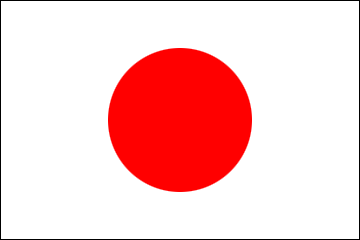Through the Eyes of the former Consul General Yamada (June, 2017 - July, 2020)
2019/7/9

Goodwill Ambassador to Spread Japanese Cuisine
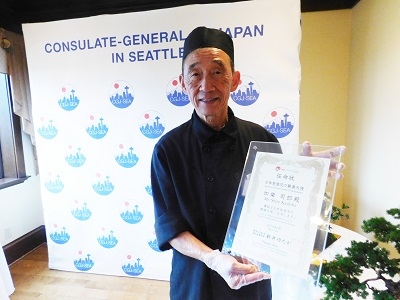
Shiro-san with the certificate bestowing upon him the title of Goodwill Ambassador to Spread Japan Cuisine
The Pacific Northwest region is blessed with an abundance of seafood. With the first Japanese immigrants arriving in the Seattle area about 130 years ago, this city has a long tradition of Japanese restaurants. Established in 1904, Maneki restaurant is the oldest Japanese restaurant still in business in North America. In recent years, as Japanese cuisine has gained popularity worldwide, there are now many restaurants in Seattle offering Japanese food. The man largely responsible for initiating the current local boom of Japanese cuisine is Chef Shiro Kashiba of Sushi Kashiba.
Shiro-san got his start as an apprentice sushi chef 60 years ago studying under the now legendary Jiro Ono at his sushi restaurant in Tokyo’s Ginza district. In 1966, interested in working abroad, Shiro-san moved to Seattle and worked at Maneki restaurant. After establishing a number of his own successful restaurants, including Nikko and Shiro’s Sushi, he opened Sushi Kashiba right next to Pike Place Market. Thus, Shiro-san fulfilled his long-held dream of opening “a sushi restaurant with a view of the sea.” As readers may know, the restaurant is continually fully booked.
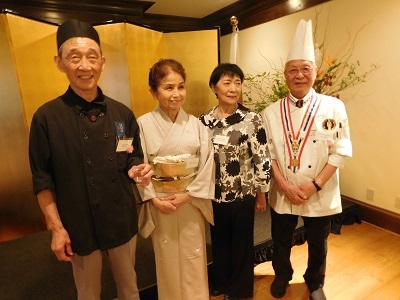
From Left: Shiro-san, Ricky-san (Shiro-san's wife), Minae-san (Suetsugu-san's wife), Suetsugu-san
About 20 Japanese restaurant owners and chefs from the Seattle area attended the reception. According to Mr. Susumu Takahashi, who has been managing restaurants in Seattle for many years, it was the first time in 50 years that he had seen such a gathering of Japanese chefs. In fact, it was Ms. Yuka Shimizu, Headmistress of Bellevue Children’s Academy, who suggested bringing local Japanese restauranteurs together for this reception. For further details about the reception, please see the articles on Jungle City (in Japanese) and in the North American Post (in English).
https://www.junglecity.com/news/sushi-kashiba-appointed-as-goodwill-ambassador-to-spread-japanese-food/
https://napost.com/shiro-kashiba-appointed-as-goodwill-ambassador-to-spread-japanese-cuisine/
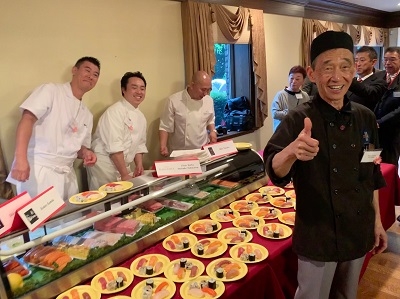
Shiro-san and chefs
Even as the number of restaurants serving Japanese food is rapidly increasing, Shiro-san and Suetsugu-san emphasize the importance of imparting the heart of Japanese cuisine through their work. After speaking with both of them, I felt that they each share a sense of integrity, diligence, and humility towards the culinary arts.
Japan’s climate provides a variety of different ingredients with every changing season, and having been formed in such an environment, Japanese cuisine places importance on the seasonal flavors offered by the harvests of each region. At grocery stores in Seattle, there are many ingredients that are the same as those in Japan, but at Shiro-san’s restaurants you will find sushi made with geoduck, smelt, and other local ingredients unique to this region.
“Local ingredients, seasonal flavors.”
Before I came to Seattle I was living in Belgium. After braving the long winters, there was much joy when spring’s arrival would bring peas (April), asparagus (May), and pickled herring (June). While visiting Croatia on our honeymoon we stopped by a small town and visited an obscure restaurant not listed in our guidebook. We never forgot the flavors of the grilled shrimp scampi and fish soup there, and when I was stationed in Kenya we chose Croatia once again for our family vacation and visited the same small restaurant.
Everyone carries their own memories of food. When we invite guests to the Residence to share a meal, unforgettable food is often a topic of conversation. In 1986, after I completed a year’s study of Russian at a military academy in Britain, I invited a teacher (and former navy officer) to a Japanese restaurant in London, only to be surprised and disappointed when he was unable to eat most of the sushi and sashimi that were served. When I later attended an international conference in Vladivostok in 1990, I was chatting with a French diplomat about sushi when a British diplomat joined the conversation. The Briton gave a look of disbelief upon hearing that one would eat slices of raw fish. At this, the Frenchman said to him, “Have you really not eaten sushi yet, something so delicious?” I clearly remember the incredulous look the Frenchman gave me after he said this. In 1990, there was only one Japanese restaurant in Moscow, where I was then posted. When I visited Moscow again on a business trip in 2005, I learned that there were nearly 400 Japanese restaurants. I was struck by how drastically things had changed.
If I meet an Italian diplomat for the first time, even if we are meeting to discuss a complicated subject, the initial topic of conversation is usually food. We will typically exchange praise for our respective culinary cultures for at least 20 minutes. I remember one diplomat in particular who said that he loved Japanese food but was previously unable to acquire a taste for tofu. However, he later told me excitedly that when he visited Tokyo on business he happened upon a tofu specialty restaurant and became absolutely fascinated by it.
The popularity of Japanese food around the world is helpful when conducting diplomacy. Chef Masuko at the Official Residence specializes in French cuisine, but in order to introduce our guests to Japanese cuisine, we serve some Japanese hors d'oeuvres in traditional black-lacquered bento boxes.
Among the some 20 genuine Japanese restaurants in the greater Seattle area, each one has devised their own characteristic dishes. Seattle can promote itself as a city in America where one can enjoy a rich variety of seafood options at different Japanese restaurants. Much like my experience at that small restaurant in Croatia, I hope that Seattle might become a place where Americans can stop by a Japanese restaurant and experience cuisine so memorable that they will keep coming back for more.
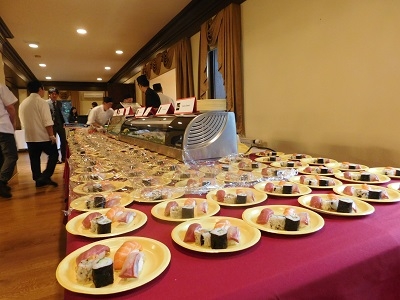
Sushi served at the reception
